Difference between revisions of "December 14, 2011"
| Line 1: | Line 1: | ||
__NOTOC__ | __NOTOC__ | ||
=Sorting Out the Rays= | =Sorting Out the Rays= | ||
| − | |||
<!-- ws:start:WikiTextHeadingRule:0:<h1> --> | <!-- ws:start:WikiTextHeadingRule:0:<h1> --> | ||
<!-- ws:start:WikiTextLocalImageRule:6:<img src="/file/view/LPOD-Dec14-11.jpg/285715018/LPOD-Dec14-11.jpg" alt="" title="" /> -->[[File:LPOD-Dec14-11.jpg|LPOD-Dec14-11.jpg]]<!-- ws:end:WikiTextLocalImageRule:6 --><br /> | <!-- ws:start:WikiTextLocalImageRule:6:<img src="/file/view/LPOD-Dec14-11.jpg/285715018/LPOD-Dec14-11.jpg" alt="" title="" /> -->[[File:LPOD-Dec14-11.jpg|LPOD-Dec14-11.jpg]]<!-- ws:end:WikiTextLocalImageRule:6 --><br /> | ||
| − | <em>image by [mailto:tosi.philippe@wanadoo.fr Philippe Tosi], Pic du Midi observatory, France</em><br /> | + | <em>image by [mailto:tosi.philippe@wanadoo.fr" rel="nofollow Philippe Tosi], Pic du Midi observatory, France</em><br /> |
<br /> | <br /> | ||
| − | High Dynamic Range (HDR) [http://www.hdrsoft.com/ software]combines multiple exposure [http://lpod.wikispaces.com/April+5%2C+2008 images] to highlight detail across the whole brightness range. Here Philippe applies it to a full Moon view of Tycho and its dark collar. This technique appears to bring out the individual raylets that often get visually fused into a confusing bright nexus. And it shows darker materials underlying the rays on the right side of the image. HDR imaging may be a new approach to detail mapping and ultimately characterizing and classifying lunar ray systems. <br /> | + | High Dynamic Range (HDR) [http://www.hdrsoft.com/" rel="nofollow software]combines multiple exposure [http://lpod.wikispaces.com/April+5%2C+2008 images] to highlight detail across the whole brightness range. Here Philippe applies it to a full Moon view of Tycho and its dark collar. This technique appears to bring out the individual raylets that often get visually fused into a confusing bright nexus. And it shows darker materials underlying the rays on the right side of the image. HDR imaging may be a new approach to detail mapping and ultimately characterizing and classifying lunar ray systems. <br /> |
<br /> | <br /> | ||
| − | <em>[mailto:tychocrater@yahoo.com Chuck Wood]</em><br /> | + | <em>[mailto:tychocrater@yahoo.com" rel="nofollow Chuck Wood]</em><br /> |
<br /> | <br /> | ||
<strong>Technical Details</strong><br /> | <strong>Technical Details</strong><br /> | ||
Revision as of 22:25, 4 January 2015
Sorting Out the Rays

image by " rel="nofollow Philippe Tosi, Pic du Midi observatory, France
High Dynamic Range (HDR) " rel="nofollow softwarecombines multiple exposure images to highlight detail across the whole brightness range. Here Philippe applies it to a full Moon view of Tycho and its dark collar. This technique appears to bring out the individual raylets that often get visually fused into a confusing bright nexus. And it shows darker materials underlying the rays on the right side of the image. HDR imaging may be a new approach to detail mapping and ultimately characterizing and classifying lunar ray systems.
" rel="nofollow Chuck Wood
Technical Details
October, 2011. C.14 with Skynyx 2.1 M + IR filter 742nm. HDR Soft Photomatix 4 developped by HDRsoft Society, fusion of 3 expositions 0.08; 0.16 and 0.32 sec.
Related Links
Rükl plate 64



